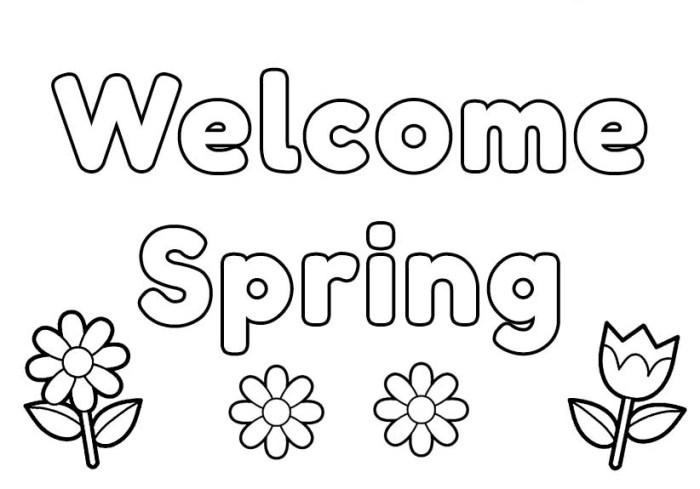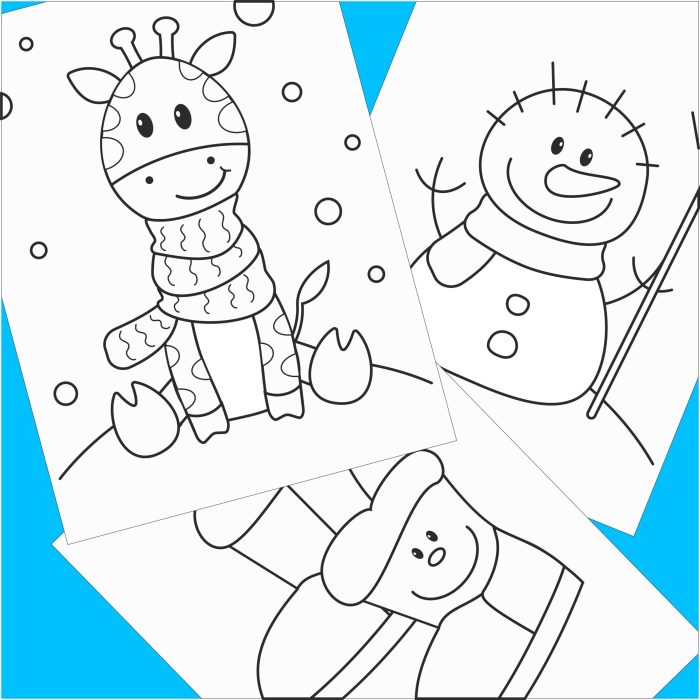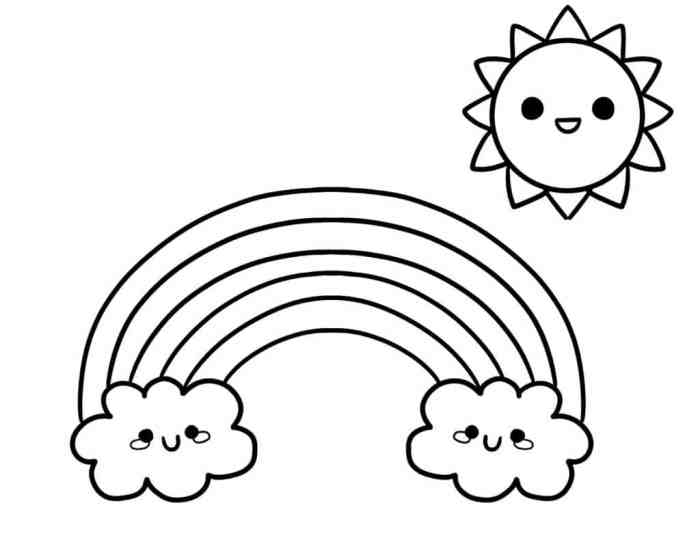Spring Themes for Coloring Pages

Coloring pages for kids spring – Spring is a vibrant season brimming with life and color, making it an ideal theme for children’s coloring pages. These pages offer a fun and engaging activity that encourages creativity and fine motor skill development while introducing young children to the beauty of springtime. The following sections detail several spring-themed coloring page concepts, image suggestions, and suitable color palettes.
Five Unique Spring-Themed Coloring Page Concepts
These five coloring page concepts are designed to be engaging for children aged 3-5, focusing on simple shapes and recognizable spring imagery.
- A cheerful sun with smiling face and radiating sunbeams. The sun could have simple details like small triangles for rays.
- A blooming flower with large, easy-to-color petals and a simple stem. Consider a daisy or sunflower for simplicity.
- A playful bunny hopping through a field of grass. The bunny should have large, round ears and a simple body shape.
- A colorful butterfly with large wings and a simple body. The wings can be divided into sections for easier coloring.
- A vibrant rainbow arcing across a clear blue sky. The rainbow can be composed of simple, wide bands of color.
Ten Common Spring-Related Images Suitable for Coloring
The following images are easy for young children to color, incorporating common spring motifs.
- Flower: A simple flower with large petals and a defined center. Children can easily fill in the petals with bright colors.
- Butterfly: A butterfly with large, clearly defined wings. The wings can be divided into sections for easier coloring.
- Blossom Branch: A branch with several simple blossoms. This allows for repetition of color and simple shapes.
- Bunny: A cartoonish bunny with large ears and a simple body. Children can add details like a fluffy tail.
- Chick: A fluffy chick with simple features. Children can use yellow and other pastel colors.
- Grass: Simple blades of grass, perhaps with a few flowers interspersed. This offers opportunities for different shades of green.
- Sun: A simple sun with radiating rays. Children can use various shades of yellow and orange.
- Rainbow: A rainbow with clearly defined color bands. This allows children to practice color recognition.
- Bird: A simple bird with large, round body and defined wings. Children can add details like a beak and eyes.
- Rain Cloud: A simple rain cloud with raindrops falling below. Children can use gray and blue for the cloud and various blues for the rain.
Suitable Color Palettes for Spring-Themed Coloring Pages
Choosing the right color palette is crucial for creating visually appealing and age-appropriate coloring pages. The palettes below offer vibrant and calming color combinations suitable for spring.
| Palette Name | Primary Colors | Secondary Colors | Description |
|---|---|---|---|
| Pastel Spring | Light Pink, Light Yellow, Light Green | Lavender, Mint Green, Pale Orange | A soft and gentle palette, ideal for younger children. Evokes a sense of calm and serenity. |
| Bright Spring | Yellow, Orange, Green | Red, Purple, Blue | A vibrant and cheerful palette, perfect for capturing the energy of spring. Suitable for bolder color choices. |
| Rainbow Spring | Red, Orange, Yellow, Green, Blue, Indigo, Violet | Various shades of primary colors | A playful palette incorporating all the colors of the rainbow. Encourages exploration of color mixing. |
| Nature Spring | Green, Brown, Blue | Various shades of green and brown, light yellow | A more realistic palette representing natural spring colors. Good for depicting landscapes and plants. |
Complexity Levels and Age Appropriateness

Designing coloring pages for children requires careful consideration of age-appropriate complexity. A coloring page that is too simple might bore older children, while one that is too intricate might frustrate younger ones. Successfully catering to different age groups necessitates a nuanced understanding of developmental stages and their corresponding fine motor skills. This involves adjusting line thickness, detail levels, and overall design complexity.Creating engaging and developmentally appropriate coloring pages involves a multifaceted approach.
The level of detail, the intricacy of the design, and the size and thickness of the lines all play a crucial role in determining the suitability of a coloring page for a specific age group. Understanding these factors allows for the creation of coloring pages that are both enjoyable and beneficial for children’s development.
Design Variations for Different Age Groups
This section details three distinct coloring page designs, each tailored to a specific age range: 3-5, 6-8, and 9-12 years old. The designs progressively increase in complexity, reflecting the developmental milestones of each age group.
- Ages 3-5: Simple Spring Flower: This design features a large, single flower with oversized petals. The petals are defined by thick, bold Artikels, leaving ample space for coloring. The stem is similarly thick and easy to follow. The overall design is uncluttered and focuses on large, easily manageable shapes. This promotes basic color recognition and hand-eye coordination without overwhelming the child.
- Ages 6-8: Spring Scene with Multiple Elements: This design incorporates multiple elements, such as a flower, a butterfly, and a few blades of grass. The Artikels are thinner than the previous design but still relatively thick, allowing for easier coloring within the lines. Simple patterns, such as stripes on the butterfly’s wings or dots on the flower petals, can be incorporated to add a small level of complexity.
This design encourages fine motor skills development and introduces more advanced color blending concepts.
- Ages 9-12: Detailed Spring Landscape: This design presents a more complex spring scene, possibly including a tree with leaves, a bird, and a more detailed background. The Artikels are thinner, requiring greater precision in coloring. Intricate patterns, such as varying leaf shapes and textures on the tree, are incorporated. This design challenges fine motor skills and encourages creativity through more nuanced color choices and shading techniques.
The level of detail requires greater concentration and patience.
Line Thickness and Detail, Coloring pages for kids spring
The thickness of lines and the level of detail are directly correlated to a child’s age and fine motor skill development. Younger children benefit from thicker lines, which provide a larger target area for coloring and reduce frustration. As children get older, thinner lines and more intricate details can be introduced to challenge and refine their fine motor skills and hand-eye coordination.
Examples of Shapes and Patterns
Choosing appropriate shapes and patterns is critical for age-appropriate coloring pages.
Spring coloring pages are awesome for celebrating all things bright and blooming! But if you’re looking for something a bit different after the spring fun, check out some festive options like these coloring pages for kids christmas – they’re perfect for getting into the holiday spirit. Then, once you’re done with those, hop back to your spring-themed pages and continue coloring the beautiful flowers and animals!
- Younger Children (3-5):
- Simple geometric shapes: circles, squares, triangles.
- Large, easily colored shapes: oversized flowers, simple animals.
- Repeating simple patterns: stripes, dots, polka dots.
- Older Children (6-12):
- More complex shapes: leaves, butterflies, birds.
- Intricate patterns: swirls, zigzags, floral patterns.
- Detailed designs: landscapes, scenes with multiple elements.
Educational Aspects of Spring Coloring Pages: Coloring Pages For Kids Spring

Spring coloring pages offer a fantastic opportunity to blend fun and learning for young children. Beyond the simple act of coloring, these pages can be designed to subtly introduce educational concepts, enhancing cognitive development and creativity. The following examples demonstrate how diverse learning objectives can be integrated into spring-themed coloring activities.
Counting and Letter Recognition Coloring Page
This coloring page features a vibrant spring meadow scene with five brightly colored butterflies. Each butterfly has a large number (1-5) printed on its wing. Scattered throughout the meadow are five flowers, each labeled with a corresponding uppercase letter (A-E). Preschoolers can color the butterflies and flowers while simultaneously practicing number recognition (1-5) and uppercase letter recognition (A-E).
The clear association between the number on the butterfly and the letter on the flower helps reinforce both skills simultaneously. The simple, large font sizes and bright colors cater to the visual learning styles of preschoolers, making the activity engaging and accessible. The overall design is simple enough to avoid overwhelming young children while still providing sufficient educational value.
Spring Flowers and Animals Identification Coloring Page
This coloring page depicts four common spring flowers (tulip, daffodil, daisy, and bluebell) and two spring animals (a bunny rabbit and a bumblebee). Each flower and animal is clearly labeled with its name, and a short description is included. For example, the tulip description might read: “Tulip: A cup-shaped flower with many different colors. They often bloom in the spring.” The bunny rabbit description could be: “Bunny Rabbit: A small mammal with long ears and a fluffy tail.
They hop around and love to eat carrots.” The detailed descriptions and clear labeling subtly introduce children to different species, fostering early vocabulary development and an appreciation for nature. The visual association between the image and the description enhances memorization and understanding. The coloring aspect provides a fun and engaging context for learning.
Creative Spring Scene Coloring Page
This activity encourages imaginative storytelling and artistic expression. The coloring page provides a basic Artikel of a spring landscape: a grassy field, a sun, and a few simple trees. Children are then invited to populate this scene with their own unique characters and details. They can add animals, flowers, houses, and any other elements they imagine in a spring setting.
This open-ended activity allows for individual creativity and self-expression. For example, a child might draw a friendly dragon flying through the sky or a family of unicorns picnicking in the meadow. The act of creating and coloring their own unique spring scene fosters imagination, enhances fine motor skills, and encourages storytelling through visual representation. This activity is highly adaptable to different age groups and skill levels, making it an inclusive and enriching educational tool.
Question Bank
What kind of paper is best for spring coloring pages?
Heavier weight paper, such as cardstock or drawing paper, is ideal to prevent bleed-through and tearing, especially with younger children.
Can I print these coloring pages in black and white?
Yes! Black and white printing allows for greater flexibility and reduces ink costs.
How can I make my own spring coloring pages?
Use simple drawing software or even hand-draw your designs and then scan them to create a printable file.
Are there any online resources for free spring coloring pages?
Yes, many websites offer free printable spring coloring pages. A simple online search should yield many results.









